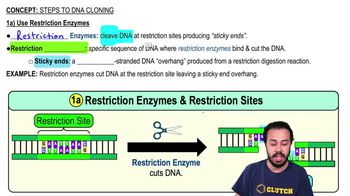Match the following choices to the statements in questions 7 through 10.
a. antisense
b. clone
c. library
d. Southern blot
e. vector
DNA that hybridizes with mRNA.
 Verified step by step guidance
Verified step by step guidance



Match the following choices to the statements in questions 7 through 10.
a. antisense
b. clone
c. library
d. Southern blot
e. vector
DNA that hybridizes with mRNA.
Differentiate the following terms. Which one is “hit and miss”—that is, does not add a specific gene to a cell?
a. protoplast fusion
b. gene gun
c. microinjection
d. electroporation
The DNA probe, 3'-GGCTTA, will hybridize with which of the following?
a. 5'-CCGUUA
b. 5'-CCGAAT
c. 5'-GGCTTA
d. 3'-CCGAAT
e. 3'-GGCAAU
Which of the following is the fourth basic step to genetically modify a cell?
a. transformation
b. ligation
c. plasmid cleavage
d. restriction-enzyme digestion of gene
e. isolation of gene
The following enzymes are used to make cDNA. What is the second enzyme used to make cDNA?
a. reverse transcriptase
b. ribozyme
c. RNA polymerase
d. DNA polymerase
DRAW IT Identify and mark each of the following in making cDNA: transcription, RNA processing, reverse transcription, DNA polymerase, cDNA.
<IMAGE>